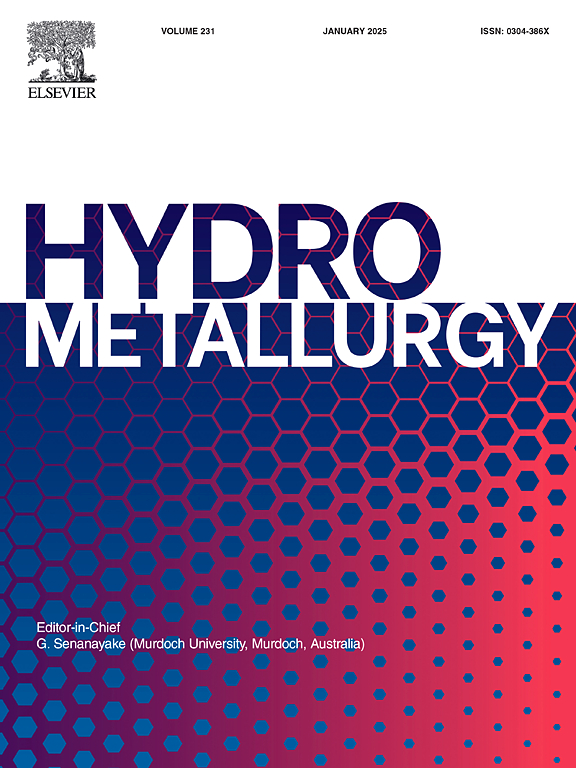Study on a functionalized ionic liquid [BIim][Cl3] for efficient dissolution of precious metals (Pd, Pt, Au, Rh)
IF 4.8
2区 材料科学
Q1 METALLURGY & METALLURGICAL ENGINEERING
引用次数: 0
Abstract
The development of industrial technology has significantly promoted the production and accumulation of spent precious metal-based catalysts. This work describes the synthesis of an ionic liquid – [BIim][Cl3] and its application as an alternative to toxic and corrosive reagents for precious metal leaching from waste catalysts. The leaching process using [BIim][Cl3] is proved to be safe and green. It offers a higher stability and higher leaching efficiency compared to other reagents used in previous publications. The ionic liquid [BIim][Cl3] enabled the efficient leaching of Pd and Au, as well as the extremely stable precious metals Pt, Rh under mild conditions. The highest leaching efficiencies achieved by [BIim][Cl3] were 99.9 %, 98.5 %, 98.6 % and 90.6 % for Pd, Au, Pt and Rh under the optimal leaching conditions, respectively. In order to reveal the leaching mechanism, XPS, far infrared (FIR), NMR, and EDS were used to demonstrate the importance of imidazolium cations in the leaching process. The leaching pathway was proposed based on the DFT calculation results on transition state energy barrier.

高效溶解贵金属(Pd, Pt, Au, Rh)的功能化离子液体[BIim][Cl3]的研究
工业技术的发展极大地促进了废贵金属催化剂的生产和积累。本研究介绍了一种离子液体--[BIim][Cl3]的合成及其在从废催化剂中萃取贵金属时作为有毒和腐蚀性试剂的替代品的应用。使用 [BIim][Cl3]的沥滤过程被证明是安全和绿色的。与之前发表的其他试剂相比,它具有更高的稳定性和更高的浸出效率。离子液体 [BIim][Cl3]能在温和的条件下高效浸出钯和金,以及极其稳定的贵金属铂和铑。在最佳浸出条件下,[BIim][Cl3] 对钯、金、铂和铑的最高浸出效率分别为 99.9%、98.5%、98.6% 和 90.6%。为了揭示浸出机理,使用了 XPS、远红外 (FIR)、NMR 和 EDS 来证明咪唑阳离子在浸出过程中的重要性。根据过渡态能垒的 DFT 计算结果,提出了浸出途径。
本文章由计算机程序翻译,如有差异,请以英文原文为准。
求助全文
约1分钟内获得全文
求助全文
来源期刊

Hydrometallurgy
工程技术-冶金工程
CiteScore
9.50
自引率
6.40%
发文量
144
审稿时长
3.4 months
期刊介绍:
Hydrometallurgy aims to compile studies on novel processes, process design, chemistry, modelling, control, economics and interfaces between unit operations, and to provide a forum for discussions on case histories and operational difficulties.
Topics covered include: leaching of metal values by chemical reagents or bacterial action at ambient or elevated pressures and temperatures; separation of solids from leach liquors; removal of impurities and recovery of metal values by precipitation, ion exchange, solvent extraction, gaseous reduction, cementation, electro-winning and electro-refining; pre-treatment of ores by roasting or chemical treatments such as halogenation or reduction; recycling of reagents and treatment of effluents.
 求助内容:
求助内容: 应助结果提醒方式:
应助结果提醒方式:


